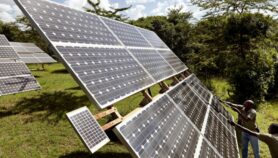By: Catherine Brahic
Send to a friend
The details you provide on this page will not be used to send unsolicited email, and will not be sold to a 3rd party. See privacy policy.
The European Union announced last week that in 2005 it had emitted about 60 million tonnes of greenhouse gases — or 3.3 per cent — less than projected.
Although this may seem positive, it is potentially bad news for the Kyoto Protocol’s Clean Development Mechanism (CDM), which has helped to fund hundreds of ‘green’ projects in the South.
Under the protocol, Europe must reduce emissions to eight per cent less than 1990 levels by 2012. One of the mechanisms for helping nations achieve this goal is the European emissions market, which allows countries that produce fewer emissions to sell their spare allowances to other countries.
The 15 May announcement left the market highly volatile. The price of one tonne of carbon dioxide emissions, which had reached an all-time high of 30 euros (US$38) at the end of April, plummeted to about eight euros before climbing back to around 15. With more than the expected emissions allowances in hand, demand vanished.
The fluctuating price of emitting a tonne of carbon dioxide into the atmosphere above Europe may seem a distant concern for climate change policymakers in developing countries. But it could have implications for their own efforts to limit contributions to climate change as they industrialise.
Clean, green development
This is because the CDM gives industrialised nations the option of offsetting their emissions at home by investing in projects that reduce emissions abroad. Some examples have been capturing gases emitted from landfills and using renewable forms of energy instead of natural gas, oil or coal to generate power.
If the price of investing abroad is cheaper than buying emissions on the EU market, as it was when the price of EU allocations climbed above 20 Euros, CDM projects become attractive options.
Their number rose rapidly last year. According to the World Bank, over 400 million tonnes of emissions reductions were agreed through the CDM in 2005 and in the first quarter of 2006.
European investors paid for more than half of this volume, with projects in China accounting for over two-thirds of it. Analysts at Point Carbon estimate that globally, in 2005, nearly two billion euros flowed to developing countries.
The surge in CDM projects is partly explained by last year’s rise in the price of emissions allowances on the European market. With now lower prices, the coming years could see European interest in financing CDM projects dwindle. Whether or not this will happen is difficult to say at the moment and will depend on how the European market evolves.
Capping the CDM
Another issue related to the CDM could be of even greater concern. EU governments are currently discussing whether to limit the proportion of emissions their industries can offset through the CDM.
With carbon prices soaring, it seemed logical that governments give their industries the option of using as many CDM-based credits as they wish. Lower prices, however, could change that and governments could end up placing the cap as low as five per cent of emissions.
This would mean that if a company emits 100 million tonnes of greenhouse gases, it can offset only five million of them by investing in emission-reducing CDM projects.
Such a trend could pose a serious threat to future ‘green’ investment in the South. The final caps are due to be confirmed on 30 June, when EU members submit national allocation plans to the European Commission.
Ultimately, however, the fall in the price of carbon in Europe could be good news for international climate change negotiations.
Benito Müller, senior research fellow at the Oxford Institute for Energy Studies, United Kingdom, believes that the flurry of CDM activity since 2005 has been based on inflated prices and false impressions that there was a lot of money to be made out of European investors.
Realism, he says, should lead to a sounder environment for projects.
Moreover, if the price of polluting had remained high, it might have made climate negotiations for the period following the end of the Kyoto Protocol, commonly referred to as ‘post-2012’, more difficult.
"There is no objective to keep the cost of mitigating climate change high," says Halldor Thorgeirsson, deputy executive secretary to the United Nations Framework Convention on Climate Change.
Quite the contrary. The convention hopes the European trading scheme will demonstrate that a cleaner atmosphere is not that costly. "It is clear that policymakers will be looking to the market for indicators of the cost of polluting," he says.
Thorgeirsson says the EU trading scheme is important as it "demonstrates that access to the atmosphere has a value".
"You could say that so far, some decisions have been based on an incomplete economic analysis because they have not factored in the cost of releasing gases into the atmosphere," he says. "That cost has not been carried by the emitter, but has been shared by the rest of humanity."













